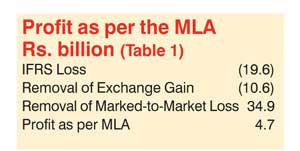Tuesday Mar 04, 2025
Tuesday Mar 04, 2025
Monday, 9 May 2016 00:00 - - {{hitsCtrl.values.hits}}
 Central Bank of Sri Lanka
Central Bank of Sri Lanka
The attention of the Central Bank of Sri Lanka has been drawn to an article that appeared in the Daily FT on 03 May 2016, written by Mr. W.A. Wijewardena (WA), a retired employee of the Central Bank of Sri Lanka. Alleging that the Monetary Board has “not heeded  the piece of advice” given by him through a previous newspaper article, he warns the Hon. Prime Minister that the Central Bank is “a landmine that could explode at any time under the Hon. Prime Minister’s feet similar to SriLankan Airlines”.
the piece of advice” given by him through a previous newspaper article, he warns the Hon. Prime Minister that the Central Bank is “a landmine that could explode at any time under the Hon. Prime Minister’s feet similar to SriLankan Airlines”.
As it is becoming increasingly evident that WA’s dogmatic and partial analyses aim to discredit the Monetary Board of the Central Bank of Sri Lanka, the Bank is of the view that a clarification is warranted for the benefit of the general public.
WA, after serving the Central Bank for a number of years, attempts to compare the Bank to SriLankan Airlines, perhaps in order to sensationalise the “issue”, and states that “the Monetary Board which had been responsible for those losses had taken a very light-hearted attitude toward them like the management of the national carrier.” In public interest, the Central Bank wishes to repeat the following extract from the Bank’s response on 14 May 2015 in the Daily FT to a previous article by WA: 2
“Generally speaking, a central bank, being the authority for the issuance of currency and monetary management, is not considered a profit oriented institution in any economy. In almost all economies, the prime objectives of central banking include maintaining price stability with a view to support economic growth and employment generation, and maintaining financial system stability. Towards these ends, central banks engage in monetary operations in both foreign and domestic markets as permitted by relevant legislation and internal guidelines. Profit or loss that accrues to central banks is a by-product of such operations, but never an objective in itself. As such, the contents of the said Article in relation to losses of the Central Bank must be viewed differently to the treatment of financial statements of profit oriented institutions.”
WA argues in his article that “the Board had argued earlier responding to this writer that losses at the Central Bank were not a problem because the Government at any time could recoup those losses.” This is a gross misrepresentation of facts, as the Bank’s stance, as stated in its response on 22 May 2015 in Daily FT, is that “the Central Bank profit/loss is a concern, but to a lesser extent than its concerns on macroeconomic objectives.”
According to WA, “the Board sought to substantiate its stand that there was no risk in the central bank making losses and allowing its net 3
worth to be depleted by quoting some academic work done elsewhere.” The Central Bank is surprised by WA’s flippant dismissal of contributions to central banking by world renowned academics and central bankers such as Barry Eichengreen, Axel Weber, Jaime Caruana, Robert Hall, and Ricardo Reis as “some academic work done elsewhere.”
WA, referring to the financial statements of the Bank published in the Central Bank Annual Report 2015, then goes on to show that the financial position of the Bank has further deteriorated in 2015, in spite of his good advice to the Central Bank through a newspaper column.
The Central Bank, while reiterating the fact “the Bank’s risk management capabilities are being strengthened continuously, in order to ensure its operations are managed properly towards the achievement of its prime objectives of maintaining economic and price stability and financial system stability” (Central Bank response on 14 May 2015 in Daily FT), wishes to inform the public that several measures have been taken in 2015/2016 to strengthen the financial position of the Bank. These include the following:
1. The Monetary Board, following a thorough consultative process, approved a comprehensive profit distribution policy where unrealised marked-to-market losses will be absorbed prudently (gains will be removed from distribution and transferred to a reserve) in addition to the removal of exchange gain/losses. Specifically;
a. Unrealised marked-to-market losses to be charged in arriving at the distributable profit;
b. Unrealised marked-to-market gains to be removed in arriving at the distributable profit and to be transferred to the Market Revaluation Reserve (MRR) with a view to building up the MRR; and
c. Where Monetary Board deems necessary, transfers may be made from the MRR to retained earnings, in the case of negative retained earnings due to significant unrealised marked-to-market losses.
2. The previous practice of quarterly profit transfers to the government as per quarterly profit certification by the external auditors, was discontinued.
Furthermore, the Monetary Board instructed the Chief Accountant of the Central Bank to make necessary amendments to the Disclosure Note on the Profit Distribution Policy of the Central Bank in the Financial Statements of the Central Bank for the year ended 31 December 2015 to be in line with the above new policy. Note 30 on Profit Distribution that appeared on Page 24 of Part II of the Central Bank Annual Report is presented in line with these instructions. This Note clearly states that, as per the Monetary Law Act (MLA) and the Monetary Board approved profit distribution policy of the CBSL (effective from 2015), adjustments are made to the net profit/loss derived in accordance with International Financial Reporting Standard (IFRS) in order to arrive at the distributable profit and also explains that due to the negative distributable profit for the year 2015,
no profit transfers were made either to the reserves or to the Consolidated Fund.
Misreading the financial statements of the Central Bank, WA argues that “when the losses are translated into the way the losses should be calculated in terms of the MLA, the picture is more alarming. In terms of these calculations, the losses have increased to Rs. 36 billion.” However, the loss of Rs. 35.8 billion in Note 30 is not the profit/loss calculated in terms of MLA which consists only the realised profits (excluding both exchange gains/losses and marked-to-market gains/losses).
As shown in Table 1 below, the Central Bank has, in fact, recorded a profit of Rs. 4.7 billion, when calculated according to the relevant provisions of the MLA. It is the Distributable profit/loss in terms of the Profit Distribution Policy of the Bank that is shown in Note 30 as a loss of Rs. 35.8 billion.
Discover Kapruka, the leading online shopping platform in Sri Lanka, where you can conveniently send Gifts and Flowers to your loved ones for any event including Valentine ’s Day. Explore a wide range of popular Shopping Categories on Kapruka, including Toys, Groceries, Electronics, Birthday Cakes, Fruits, Chocolates, Flower Bouquets, Clothing, Watches, Lingerie, Gift Sets and Jewellery. Also if you’re interested in selling with Kapruka, Partner Central by Kapruka is the best solution to start with. Moreover, through Kapruka Global Shop, you can also enjoy the convenience of purchasing products from renowned platforms like Amazon and eBay and have them delivered to Sri Lanka.
Discover Kapruka, the leading online shopping platform in Sri Lanka, where you can conveniently send Gifts and Flowers to your loved ones for any event including Valentine ’s Day. Explore a wide range of popular Shopping Categories on Kapruka, including Toys, Groceries, Electronics, Birthday Cakes, Fruits, Chocolates, Flower Bouquets, Clothing, Watches, Lingerie, Gift Sets and Jewellery. Also if you’re interested in selling with Kapruka, Partner Central by Kapruka is the best solution to start with. Moreover, through Kapruka Global Shop, you can also enjoy the convenience of purchasing products from renowned platforms like Amazon and eBay and have them delivered to Sri Lanka.